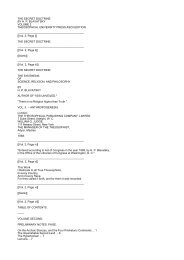Create successful ePaper yourself
Turn your PDF publications into a flip-book with our unique Google optimized e-Paper software.
The Gods Of The <strong>Book</strong> Of The <strong>Dead</strong>.<br />
advanced to pure mono<strong>the</strong>ism because <strong>the</strong>y never succeeded in freeing <strong>the</strong>mselves from <strong>the</strong> belief in <strong>the</strong><br />
existence <strong>of</strong> o<strong>the</strong>r gods, but when <strong>the</strong>y say that a god has "no second," even though <strong>the</strong>y mention o<strong>the</strong>r<br />
"gods," it is quite evident that like <strong>the</strong> Jews, <strong>the</strong>y conceived him to be an entirely different being from <strong>the</strong><br />
existences which, for <strong>the</strong> want <strong>of</strong> a better word, or because <strong>the</strong>se possessed superhuman attributes, <strong>the</strong>y<br />
named "gods."<br />
The powers <strong>of</strong> darkness or evil.<br />
The gods above enumerated represent <strong>the</strong> powers who were <strong>the</strong> guides and protectors and givers <strong>of</strong> life<br />
and happiness to <strong>the</strong> deceased in <strong>the</strong> new life, but from <strong>the</strong> earliest times it is clear that <strong>the</strong> Egyptians<br />
imagined <strong>the</strong> existence <strong>of</strong> o<strong>the</strong>r powers who <strong>of</strong>fered opposition to <strong>the</strong> dead, and who are called in many<br />
places his "enemies." Like so many <strong>of</strong> <strong>the</strong> ancient gods, <strong>the</strong>se powers were originally certain forces <strong>of</strong><br />
nature, which were believed to be opposed to those which were regarded as beneficient to man, as for<br />
example darkness to light, and night to day; with darkness and night were also associated <strong>the</strong> powers<br />
which contributed in any way to obscure <strong>the</strong> light <strong>of</strong> <strong>the</strong> sun or to prevent his shining. But since <strong>the</strong><br />
deceased was identified with Horus, or Ra, and his accompanying gods, <strong>the</strong> enemies <strong>of</strong> <strong>the</strong> one became<br />
<strong>the</strong> enemies <strong>of</strong> <strong>the</strong> o<strong>the</strong>r, and <strong>the</strong> welfare <strong>of</strong> <strong>the</strong> one was <strong>the</strong> welfare <strong>of</strong> <strong>the</strong> o<strong>the</strong>r. When <strong>the</strong> Egyptians<br />
personified <strong>the</strong> beneficent powers <strong>of</strong> nature, that is say, <strong>the</strong>ir gods, <strong>the</strong>y usually gave to <strong>the</strong>m human<br />
forms and conceived <strong>the</strong>m in <strong>the</strong>ir own images; but when <strong>the</strong>y personified <strong>the</strong> opposing powers <strong>the</strong>y<br />
gave to <strong>the</strong>m <strong>the</strong> shapes <strong>of</strong> noxious animals and reptiles, such as snakes and scorpions. As time went on,<br />
<strong>the</strong> moral ideas <strong>of</strong> good and right were attributed to <strong>the</strong> former, and evil and wickedness to <strong>the</strong> latter. The<br />
first personifications <strong>of</strong> light and darkness were Horus and Set, and in <strong>the</strong> combat--<strong>the</strong> prototype <strong>of</strong> <strong>the</strong><br />
subsequent legends <strong>of</strong> Marduk and Tiamat, Bel and <strong>the</strong> Dragon, St. George and <strong>the</strong> Dragon, and many<br />
o<strong>the</strong>rs--which took place between <strong>the</strong>m, <strong>the</strong> former was always <strong>the</strong> victor. But, though <strong>the</strong> deceased was<br />
identified with Horus or Ra, <strong>the</strong> victory which <strong>the</strong> god gained over Set only benefited <strong>the</strong> spiritual body<br />
which dwelt in heaven, and did not preserve <strong>the</strong> natural body which lay in <strong>the</strong> tomb. The principal enemy<br />
<strong>of</strong> <strong>the</strong> natural body was <strong>the</strong> worm, and from <strong>the</strong> earliest times it seems that a huge worm or serpent was<br />
chosen by <strong>the</strong> Egyptians as <strong>the</strong> type <strong>of</strong> <strong>the</strong> powers which were hostile to <strong>the</strong> dead and also <strong>of</strong><br />
[1. ###, Deut. vi., 4. Compare ###, Deut. iv., 35; and ###, Isaiah xlv., 5.]<br />
{p. cxxix}<br />
<strong>the</strong> foe against whom <strong>the</strong> Sun-god fought. Already in <strong>the</strong> pyramid <strong>of</strong> Unas a long section <strong>of</strong> <strong>the</strong> text<br />
contains nothing but formulæ, <strong>the</strong> recital <strong>of</strong> which was intended to protect <strong>the</strong> deceased from various<br />
kinds <strong>of</strong> snakes and worms.[1] These are exceedingly ancient, indeed, <strong>the</strong>y may safely be said to form<br />
one <strong>of</strong> <strong>the</strong> oldest parts <strong>of</strong> <strong>the</strong> funeral literature <strong>of</strong> <strong>the</strong> Egyptians, and we find from <strong>the</strong> later editions <strong>of</strong> <strong>the</strong><br />
<strong>Book</strong> <strong>of</strong> <strong>the</strong> <strong>Dead</strong> and certain Coptic works that <strong>the</strong> dread <strong>of</strong> <strong>the</strong> serpent as <strong>the</strong> emblem <strong>of</strong> physical and<br />
moral evil existed among <strong>the</strong> Egyptians in all generations, and that, as will be seen later, <strong>the</strong> belief in a<br />
limbo filled with snakes swayed <strong>the</strong>ir minds long after <strong>the</strong>y had been converted to Christianity.<br />
The charms against serpents in <strong>the</strong> pyramid texts <strong>of</strong> <strong>the</strong> Vth and VIth dynasties have <strong>the</strong>ir equivalents in<br />
<strong>the</strong> XXXIst and XXXIIIrd Chapters <strong>of</strong> <strong>the</strong> <strong>Book</strong> <strong>of</strong> <strong>the</strong> <strong>Dead</strong>, which are found on c<strong>of</strong>fins <strong>of</strong> <strong>the</strong> XIth and<br />
XIIth dynasties;[2] and in <strong>the</strong> XVIIIth dynasty we find vignettes in which <strong>the</strong> deceased is depicted in <strong>the</strong><br />
act <strong>of</strong> spearing a crocodile[3] and <strong>of</strong> slaughtering serpents.[4] In <strong>the</strong> Theban and Saïte versions are<br />
several small chapters[5] <strong>the</strong> recital <strong>of</strong> which drove away reptiles; and <strong>of</strong> <strong>the</strong>se <strong>the</strong> most important is <strong>the</strong><br />
XXXIXth Chapter, which preserved <strong>the</strong> deceased from <strong>the</strong> attack <strong>of</strong> <strong>the</strong> great serpent Apef or Apep, who<br />
is depicted with knives stuck in his folds.[7] In <strong>the</strong> period <strong>of</strong> <strong>the</strong> later dynasties a service was performed<br />
http://www.sacred-texts.com/egy/ebod/ebod09.htm (16 <strong>of</strong> 19) [8/10/2001 11:23:59 AM]

















